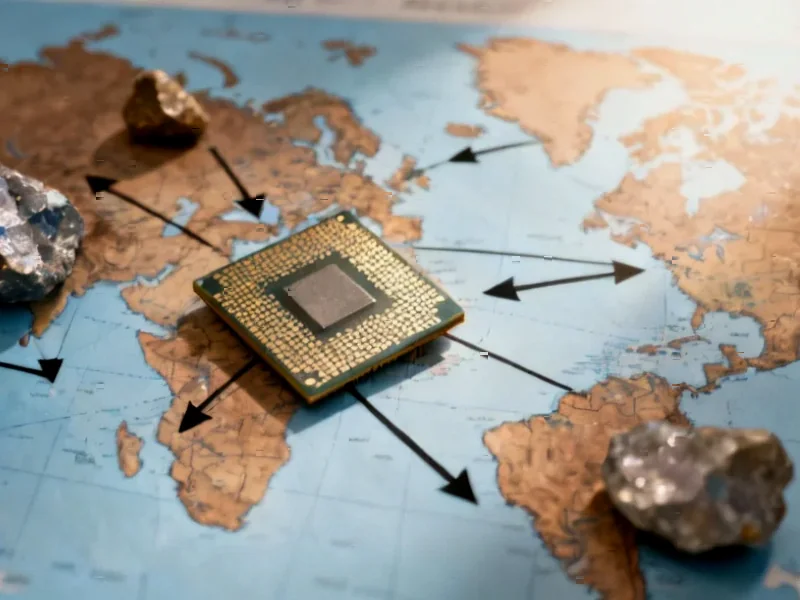According to TheRegister.com, last week’s trade talks between the USA and China resulted in Beijing lifting restrictions on rare earth exports and promising to terminate various investigations targeting US semiconductor companies including Nvidia, Qualcomm, and Micron. The White House fact sheet also revealed China will ensure resumption of trade from Nexperia’s facilities in China, while Singapore police seized over S$150 million ($115 million) in assets linked to alleged scam camp operator Chen Zhi. In other developments, Google announced free Gemini Pro accounts for Jio’s 200 million+ 5G subscribers in India, Australia’s securities regulator raided WiseTech Global offices, and IDC predicted 16.4% growth in India’s enterprise infrastructure market by 2025. These developments signal significant shifts across global technology markets.
Strategic Minerals and Semiconductor Supply Chains
The rare earth export decision represents a critical inflection point for global technology manufacturing. China currently controls approximately 60% of global rare earth production and nearly 90% of processing capacity, making this reversal particularly significant for industries ranging from electric vehicles to defense systems. The timing is crucial as Western companies have been scrambling to develop alternative supply chains, with the US investing heavily in domestic rare earth processing through recent legislation.
More importantly, the cessation of semiconductor investigations removes a major cloud hanging over US chip designers. Nvidia and Qualcomm derive substantial revenue from Chinese markets, and the threat of regulatory action had been complicating their strategic planning. The Chinese Commerce Ministry’s stance on Nexperia suggests Beijing is taking a more pragmatic approach to technology interdependence, recognizing that complete decoupling serves neither economy’s interests.
Google’s Strategic Gambit in India’s Digital Future
Google’s massive AI giveaway to Jio subscribers represents one of the most aggressive user acquisition plays in recent memory. With over 200 million potential 5G subscribers gaining access to Gemini Pro, Google is effectively creating an entire generation of AI-native users who will likely remain within its ecosystem. The specific targeting of 18-25 year olds is particularly strategic, as this demographic represents India’s future workforce and consumer base.
The inclusion of 2TB storage specifically for WhatsApp backup reveals Google’s acknowledgment of Meta’s entrenched position in Indian digital life. This represents a pragmatic concession that even Google’s vast resources cannot displace certain established platforms. The partnership with Jio, which controls nearly 40% of India’s telecom market, gives Google unprecedented distribution scale in a market where smartphone penetration continues to accelerate rapidly.
India’s Infrastructure Investment Surge
IDC’s projection of 16.4% growth in India’s enterprise infrastructure market, while starting from a relatively modest base of around $6 billion, signals a fundamental shift in global technology investment patterns. The contrast with US infrastructure spending—$82 billion in just Q2 2025—highlights both the growth potential and current under-penetration in Indian markets. What makes this growth particularly significant is its composition: professional services firms driving AI infrastructure and financial services modernizing core systems.
The emphasis on “cloud-native, software-defined, and AI-ready architectures” suggests Indian enterprises are leapfrogging legacy infrastructure challenges that still plague many Western organizations. This positions India not just as a consumption market but as a potential exporter of modern infrastructure management practices. The stringent data localization requirements mentioned by IDC are creating a unique environment where global cloud providers must adapt their offerings to comply with Indian regulations while maintaining competitive performance.
Cross-Border Regulatory Coordination Intensifies
The Singapore asset seizures linked to alleged Cambodian scam operations demonstrate increasingly sophisticated cross-border enforcement against technology-enabled financial crimes. The scale of the seizure—$115 million across multiple asset classes—indicates law enforcement is developing the capability to track and intercept complex cryptocurrency-based fraud operations. The Singapore Police’s detailed accounting of seized assets suggests improved international cooperation in financial intelligence sharing.
Similarly, the Australian Securities and Investments Commission’s raid on WiseTech Global, following allegations of improper share trading, reflects growing regulatory scrutiny of technology company governance. As tech firms represent increasingly significant portions of national stock indices, regulators are taking a more active role in ensuring compliance with trading restrictions, particularly around blackout periods when insiders possess material non-public information.
Global Technology Partnerships Evolve
The European Space Agency’s decision to establish a permanent Tokyo office represents another dimension of international technology collaboration. Following its Washington DC presence, ESA’s expansion into Japan signals that space technology is becoming increasingly multilateral rather than dominated by US-China competition. This mirrors broader trends in technology where middle powers are forming strategic partnerships to maintain relevance in an increasingly bipolar tech landscape.
These developments collectively paint a picture of a global technology ecosystem that’s simultaneously fragmenting along geopolitical lines while becoming more interconnected through strategic partnerships and regulatory coordination. The challenge for technology leaders will be navigating this complex landscape where national security concerns, economic interdependence, and innovation imperatives must be balanced in real-time.




